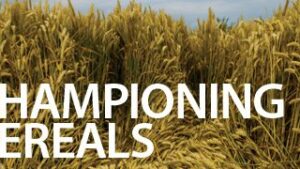End Point Royalties
How can cereal producers have future access to the best global genetics for wheat and barley? One solution is an end point royalty.
Producers depend on new technologies to keep cereals competitive in crop rotations and in world markets. Globally, private cereal varieties are now under development that could create important benefits and changes for producers in Canada.
Public Breeding in Canada — A History of Success
In addition to the early maturity, which is so important in our short growing season, breeders have continuously improved yield, quality and disease resistance in Canadian cereal crops. In Canada, wheat and barley variety improvements, like in the United States, have been done primarily by the public sector. More than 100 years ago, the federal government established agricultural research and experimental stations to support economic development in Canada. Wheat received special focus, as it was well suited and strategic to the development of the Prairies.
Western Canada’s short growing season, low rainfall and unique plant diseases required a long-term commitment and vision to develop the highly adapted germplasm found in public breeding programs today. In fact, varieties from public breeding today represent more than 85 per cent of the seeded wheat acres in Western Canada (in the U.S., more than 70 per cent).
In recent years however, public breeding investment in real dollar terms has been eroded due to inflation and public sector budget cuts. Partially offsetting this has been a producer-funded levy (check-off) on wheat and barley that was introduced in 1993 and administered by the Western Grains Research Foundation. These levies by law could only be used for wheat and barley breeding research. It is estimated that this producer contribution to breeding research has paid for approximately 30 per cent of the cost of public breeding projects (excluding assets and overhead costs).
Over time, Canada’s public breeders have developed a unique and valuable wheat germplasm. This is the result of a 100-year wheat breeding history that has emphasized milling quality and protein content.
Wheat — The Last Frontier
The breeding of wheat is genetically complex and complicated by agronomic factors. This makes breeding efforts expensive. The practice of using farm-saved seed (FSS) makes royalty collection difficult and results in a low return on investment for breeders. As a result, private companies which have become world leaders in the breeding of corn, soybean, canola, fruit and vegetable crops have not been as active in cereal crop breeding.
However, things are changing. Wheat is the second-largest crop in the world and private breeders see business growth opportunities in markets where the investment climate is right. Barley is also being displaced by corn in some areas as shorter season varieties become available. Wheat breeding is global, as demonstrated in the New Private Wheat Research Investments Timeline following this article.
Investment Climate and UPOV 91
Canadian producers need access to the best technologies available in order to improve yields and address other agronomic issues as they emerge. While public breeding will continue to play a significant role in technology and variety development, Canada must also encourage global seed company investments in wheat and barley breeding, and to do so the right investment climate must exist. To make this happen, the federal government is considering updating Canada’s Plant Breeders’ Rights (PBR) Act. Amendments under consideration would cause PBR legislation to conform to the most recent international standards, called UPOV 91. Conforming to UPOV 91 would give plant breeders in Canada more opportunity to collect royalties on PBR protected varieties. This would improve returns on plant breeding investments for both public and private plant breeders while also increasing intellectual property protection of varieties.
For producers, a key outcome of applying UPOV 91 standards is that breeders will be eligible by law to receive a royalty on their varieties any time seed of their protected variety is planted. For cereal producers, this would include farm-saved seed. This creates a dilemma. Producers need and want access to the best genetics so that they can continue to produce high-quality, internationally competitive products, but also want the cost savings that come with planting farm-saved seed. An end point royalty offers a solution.
End Point Royalty — What is it?
How can a royalty be collected on FSS? One method is for producers to keep records of the amount of FSS stored and sown. This method is used in Uruguay. Twice a year, breeder’s representatives visit each farm to record the variety and quantity of FSS planted. In Western Canada, visits to individual farms to record seed storage and planting data would be costly to administer because of the large number of farms and the distance between them. This level of oversight would also be objectionable to most farmers.
UPOV 91 standards allow that if the breeder does not have ‘reasonable opportunity’ to exercise his right to collect a royalty on the seed (in this case, FSS or certified seed), then the breeder may collect a royalty on the grain that is produced from the seed. When the royalty is collected on the grain harvested and not on the seed, it is called an end point royalty (EPR).
End point royalties have proven to be successful in Australia at financing crop breeding. First introduced in 1996, wheat varieties with EPR have reached more than 80 per cent of the market share. One reason it works so well is that it provides a return to breeders when FSS is planted. As Ross Kingwell, an economist at the University of Western Australia, says: “Where farm-saved seed is common practice, the characteristics of end point royalties are shown to make them a preferred means for financing crop breeding by variety developers, governments and many grain growers.”
How EPRs Work
An EPR is a mechanism used by plant breeding companies to recover their return on investment. It is a risk sharing mechanism since the producer of the crop pays a royalty on the production and not on the seed. The amount of the royalty is set by the breeder and may be dollars per tonne or a percentage of value.
The EPR is a royalty charge imposed on the first sale of harvested material derived from varieties protected by plant breeders. If the EPR is charged, then no royalty is applied to the certified seed. Breeders are not allowed to collect two royalties on both seed and on production. When a producer chooses to plant a variety protected by PBR (under UPOV 91 standards), it becomes the law to pay the royalty as established by the plant breeder. If a producer does not want to pay EPR, then the producer should not utilize the technology of the PBR-protected variety by planting the seed.
When grain is delivered to the first point of sale, the producer will declare the variety name. If an EPR is in effect on the variety, the grain buyer will deduct the royalty amount due to the breeder and remit the funds to the breeder or to the breeder’s agent.
Advantages to End Point Royalties
1. Practical, streamlined method of remitting a royalty on PBR-protected varieties, resulting in a low administration cost.
2. Buyers in Western Canada have already established the administrative systems for check-off (levy) collection.
3. More practical to implement than a royalty on FSS and less offensive to farmers, as collection does not require on-farm monitoring.
4. EPR is a performance-based royalty system; producers and breeders share the risk of variety performance.
Debunking the Myths
Will Producers Pay Twice?
Producers currently pay a compulsory but refundable check-off (levy) for wheat and barley development via provincial wheat and/or barley commissions. If an EPR is introduced, some producers may think that they are paying twice for the same thing. They are not. The commission check-offs currently support research, market development and technical assistance programming in Western Canada. This is producer money used to support activities determined by producer representatives. An EPR, on the other hand, is money owed to the plant breeder for use of the variety protected by PBR. It is not refundable. Its purpose is to provide the breeder with a return on investment for their cost and risk in developing the new variety. An EPR and a check-off are two distinctly different mechanisms achieving different outcomes — producers do not pay twice for the same thing.
Will EPR Harm the Seed Industry?
Breeders currently collect a royalty built into the price of a certified seed. Some worry that if the royalty is moved from seed to grain production, it will harm seed growers and seed companies. Application of EPR does not change the Seeds Act in Canada and will not reduce the vitality and role of the pedigreed seed industry. Seed growers and seed companies will continue to be needed for cereal seed production and distribution. Contrary to the seeding practices in the canola industry, where five pounds of canola is needed to seed an acre and seed is processed at central locations and shipped to customers, wheat and barley have much higher seeding rates — making seed production and processing decentralized across the Prairies. Cereal breeders will continue to need local suppliers and distributors to provide cost-effective offerings to producers.
Canadian producers need access to new technologies and global genetics. The implementation of an end point royalty in Canada will help attract global investment in cereal breeding. To maintain pace with other competitors, Canada needs a strong investment environment that rewards private companies for their investment and risk in developing new, improved cereal varieties.
Stuart Garven
Editor’s Note: Stuart Garven is a management consultant specializing in the agriculture and food industries. He has been a member of a team of consultants that has conducted an investigation into the development of a new cereal breeding model for Western Canada. The model includes new funding methods and partnerships in cereal breeding involving producers and the public and private sectors. The Alberta Seed Growers’ Association has provided leadership by creating a consortium of producer organizations that have funded and undertaken this investigation. In addition to funding from some producer organizations, funding has also been provided by the Canadian Agriculture Adaptation Program.
Timeline for Recent Private Wheat Research Investments:2008 2009 2010 2011 2012 2013 |












